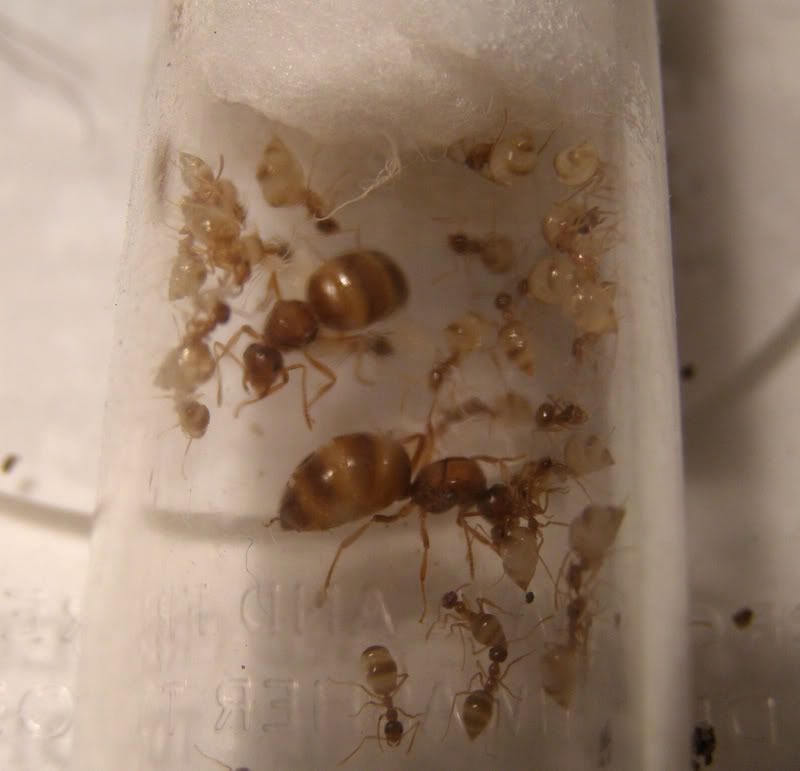Post by Deleted on Jan 24, 2012 6:22:06 GMT 1
[bg=a3b44f][atrb=border,0,true] |
[bg=fbd9bd] Photo from www.alexanderwild.com |
[bg=a3b44f] |
| [bg=fbd9bd] Taxonomy: Formicinae (Prenolepis) Colony type: Weakly Polygynous (Multiple queens) Queen: Fully Claustral Color: Dark Orange-Brown. Some red and dark brown variations are known. Size: Queen 7-9 mm / Workers 2-4 mm Distribution: Mid US, possibly as far North as Canada. Nutrition: Honey water, fruits, small insects, Temperature:Room temperature - 3-4 degrees warmer Hibernation: Not necessary, but advised. Air humidity: Moderate climate Nest building: Natural; sand, soil, loam. Artificial; Pumice, Y-Tong, Plaster, Glass, ect. Planting: Not Necessary Class: Easy |
[bg=a3b44f] |
| [bg=fbd9bd] Prenolepis imparis (Henceforth known as P. imparis) is a small ant that is highly distributed throughout the United States, and is considered a great starter species. P. imparis is only native the US and isn’t found anywhere else. They are the only Prenolepis native to North America, though many believe that there are actually more than one species or sub-species of P. imparis in NA. P. imparis have the ability to shoot formic acid in defense, something that is basically harmless to humans unless it hits your eyes. Mature nests usually contain from 1,000 to 10,000 individuals, and queens live for 15-20 years in proper conditions. They will eat insects, nectar, honey, sugar water, and fruits. P. imparis are widely known as ‘Winter Ants’ and ‘False Honey Pot Ants’ since their flights occur from March to April, occasionally entering May, and their workers can become repletes. |
[bg=a3b44f] |
| [bg=fbd9bd] P. imparis is known to be both polygynous (Having multiple queens) and monogynous (Having one queen) and often form colonies together. Occasionally queens will fight until one reigns supreme. Queens usually start colonies with 10-15 workers and are known for laying lots of eggs afterwards. Colonies start up very quickly. Queens are said to only lay a few batches of eggs a year. |
[bg=a3b44f] |
| [bg=fbd9bd] P. imparis seem to prefer their nests on the wetter side, and use of dirt/sand is advised for comfort. Because of their small size, formicariums will last long, and colonies can get quite large, quickly. P. imparis can be kept in Plaster, Hydrostone, Y-Tong (Rarely), Pumice, Slim Nests, Tanks, and of course trusty test tubes. |
[bg=a3b44f] |
| [bg=fbd9bd] Prenolepsis imparis eat insects, nectar, honey, sugar water, fruits. They also need access to fresh water at all times. |
[bg=a3b44f] |
| [bg=fbd9bd] P. imparis does not shoot formic acid very often, but do use it for defense sometimes. They are fairly easy to keep, and are suitable for kids 11 and up, depending on maturity level. Petroleum Jelly/Vaseline is often used as an escape deterrent. |
[bg=a3b44f] |
| [bg=fbd9bd] P. imparis hibernate in the wild and normally wake up in February. It is advised that they are hibernated in order to stimulate the queen into laying again. P. imparis have repletes and use them primarily to feed from during the winter and in times of crisis. |
[bg=a3b44f] |
| [bg=fbd9bd] |
Live Colony W/ Commentary About Experiment
Mating Flight

[url=http://antsbeesbutterfliesnature.blogspot.comMr. I Love The Ants

